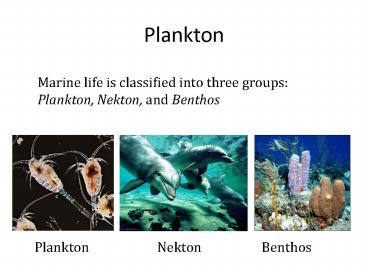Plankton - PowerPoint PPT Presentation
1 / 42
Title:
Plankton
Description:
Plankton Marine life is classified into three groups: Plankton, Nekton, and Benthos Nekton Plankton Benthos Deep-Scattering Layer How to capture zooplankton ... – PowerPoint PPT presentation
Number of Views:1193
Avg rating:3.0/5.0
Title: Plankton
1
Plankton
Marine life is classified into three groups
Plankton, Nekton, and Benthos
Benthos
2
Plankton
- Plankton refers to the drifting organisms within
the pelagic zone - Phytoplankton are autotrophic, photosynthetic
algae, which form the base of the marine food web - Zooplankton are heterotrophic the primary (and
in some cases secondary and tertiary) consumers
of the marine food web
3
Plankton form the base of the marine food web
4
Bottom of the Food Chain
5
How are plankton classified?
- By Metabolism (autotrophic vs. heterotrophic)
- By Life History (meroplankton vs. holoplankton)
- By Taxonomy (Crustaceous vs. Gelatinous
zooplankton, for example)
http//www.whoi.edu/annualreport02/highlights/glob
ec_en3.html
6
Phytoplankton
- Phytoplankton are responsible for 40 of all the
worlds photosynthetic food on Earth (and 95 of
all the oceans!) - Provide one half of all the oxygen we breathe!
- Collectively, the production of organic compounds
from CO2 is referred to as primary productivity
7
Phytoplankton
- Phytoplankton require nutrients, especially
nitrogen and phosphorus (macronutrients) but also
iron (micronutrients) - For this reason, phytoplankton appear in
abundance (blooms) in regions of upwelling,
where cold, nutrient-rich water reaches the
photic zone
8
(No Transcript)
9
Global Primary Productivity
http//www.nasa.gov/centers/goddard/images/content
/95573main_plankton_satellite.jpg
10
Localized Primary Productivity
- In tropical regions, there is plenty of sunlight
but productivity is limited by nutrients trapped
beneath the thermocline - In polar regions, there are plenty of nutrients,
but sunlight (and sinking out of the photic zone
via mixing) limits productivity - In temperate regions, the combination of sunlight
and nutrients is just right, but only seasonally!
11
Tropical Productivity Profile
12
Primary Productivity in Temperate Regions
- Localized primary productivity occurs seasonally,
accompanied by physical changes to the water
column - In temperate regions, primary productivity is
limited by light (winter) and by nutrients
(summer) - Peak productivity occurs during spring, in an
abundance of phytoplankton known as a spring
bloom
13
(No Transcript)
14
Primary Productivity in Temperate Regions
- During winter, nutrients are at their highest,
but light is at its lowest - In spring, solar energy reaching the photic zone
increases and nutrients are still abundant - In summer, strong warming of the water creates a
seasonal thermocline which restricts nutrients
from reaching the photic zone - In fall, storms enhance mixing, and a second
seasonal bloom results
15
(No Transcript)
16
Compensation Depth
- Net primary productivity is the amount of carbon
dioxide removed via photosynthesis minus the
amount of carbon dioxide released by respiration - Compensation depth refers to the depth in the
water column at which the rate of photosynthesis
equals the rate of respiration - Above this depth, phytoplankton survive
- Below this depth, phytoplankton die
17
(No Transcript)
18
Phytoplankton
- Phytoplankton are mostly single-celled algae
(Kingdom Protista) - There are 8 major types of phytoplankton, 2 of
which are most prominent - Diatoms
- Dinoflagellates
19
Diatoms
- Dominant (gt5,600 species)
- Composed of silica shells
- Important source of nutrition for zooplankton
v
20
Dinoflagellates
- Can be autotrophic or heterotrophic!
- Most are planktonic, but others form symbiotic
relationships with coral (zooxanthellae) and
giant clams - Flagella for movement
- Responsible for red tides
(harmful algal blooms)
21
Red Tide caused by Dinoflagellate
22
Harmful Algae Blooms (HABs)
Caused by dinoflagellates and other small
flagellates
23
Zooplankton
- Zooplankton are the most numerous primary
consumers in the ocean - The most important source of protein in the
oceans! - Zooplankton eat bacteria, phytoplankton, and
other zooplankton! - Nearly every major animal group is represented in
the zooplankton
24
Zooplankton
- Zooplankton are classified as either
- Holoplankton
- Meroplankton
- Holoplankton are always plankton they live and
die in the water column - Meroplankton are only plankton for part of their
lives many marine organisms begin their lives as
small planktonic organisms, but gain the ability
to swim or metamorphose into a benthic organism
25
Holoplankton
Once a copepod, always a copepod
26
Meroplankton
- Includes larval (very young) fish, crabs, clams,
squid, lobsters, starfish, etc.
27
(No Transcript)
28
Types of Zooplankton Copepods
- Copepods are the most abundant of all the
zooplankton (70) - Holoplanktonic
- Crustaceous
- Herbivorous, Omnivorous, Carnivorous, and
Parasitic - Marine and freshwater
29
Copepods
- 14,000 species globally
- You, too, can become a copepodologist!
- Important source of protein for secondary
consumers!
30
Types of Zooplankton Pteropods
Composed of calcium carbonate, CaCO3
31
Jellyfish and ctenophores are gelatinous
zooplankton!
32
Avoiding Predation
- Translucence and Transparency
- Outward spines for protection
- Swimming behavior and migration
33
The Greatest Migration on Earth
Increasing Depth
34
(No Transcript)
35
Deep-Scattering Layer
36
How to capture zooplankton
37
Quantitative Zooplankton Tows
38
Think Like Plankton
- Life in a pelagic habitat (no solid substrate)
3-D - Properties of water
39
Properties of Water
- Water is viscous, ESPECIALLY if you are a very
small organisms living in it - Reynolds number
- Re inertial forces
viscous forces
40
Reynolds Number
- For very small organisms, inertia is
non-existent - Viscous forces dominate (low Reynolds number)
for small organisms, such as plankton! - Inertial forces dominate (high Reynolds number)
for larger organisms, such as humans, large fish
or whales
41
Reynolds Number
http//brodylab.eng.uci.edu/jpbrody/reynolds/figu
re3.gif
42
(No Transcript)































